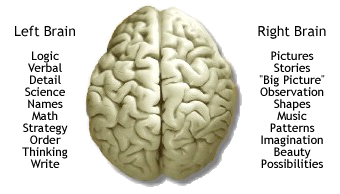It is a common mathematical concept — two halves make a whole. In math, we are typically taught that when something is broken into halves, it has been divided into two equal parts. The same can be said of the brain.
A Little Background Information
The brain is divided into two hemispheres, the right and the left. The left hemisphere controls the right side of your body and is involved in sequential processing. The right hemisphere controls the left side of the body and processes in a spatial/relational manner. Although the hemispheres process information in very different ways, they work in a complementary fashion through a connection of about 300 million nerve fibers in the corpus callosum.
While the corpus callosum connects the two hemispheres of the brain physically, there is a need to connect instruction to each hemisphere. In order to be effective in designing educational programs, lessons, and curricula, we must understand a few basic tenants:
Learners use Both Sides of Their Brains
When we indicate that a person is right-brained, it is not an indication that he or she does not utilize the left hemisphere of the brain. What we are saying is that this person uses the right hemisphere of the brain to a greater degree than the left. Hemispheric dominance relates to the part of the brain that handles the majority of the information in any given task; this is the hemisphere that responds first. Everyone uses both hemispheres of the brain. People who have a dominant Green or Gold temperament are left-brained, and those who have a dominant Orange or Blue temperament are right-brained.

Left Hemisphere Processing = Part to Whole
Gold and Green learners who operate primarily from the left hemisphere of the brain process from part to whole. For these learners, processing is linear, sequential, logical, symbolic, and verbal. They gather a myriad of parts and use them to construct whole ideas and concepts.
Right Hemisphere Processing = Whole to Part
While the left hemisphere is puzzling with the parts; the right is interested in the whole picture. For Orange and Blue learners operating primarily from the right hemisphere processing is random, concrete, and intuitive. Once they have uncovered the relationships and patterns of an idea or concept, they can then take a closer look at the parts that are involved.
Subject Areas Have No Hemisphere Preference
While there are some subjects that seem to lean more heavily toward the processing styles of each hemisphere, there are no subjects that are solely in the domain of the right or left hemisphere. For example, a student in math may memorize theorems or facts (left) for later use in high-level problem solving situations (right).
The Balanced Approach: Teaching in the Nexus
Traditionally, much of what occurs in formal education is within the realm of the left hemisphere. We place a high value on a student’s ability to verbalize their understanding of a concept. We instruct, using lecture and text, in a linear progression. This strongly left-leaning approach limits all students and not just student who process primarily in the right hemisphere. Left brain dominant students need to strengthen their abilities to use right brained processes and vice-versa.
To build effective whole brain thinkers, we must consciously strive to teach to the nexus: the place where we connect. We must include activities in our instructional design that build connections between the hemispheres. As a system, we seem to be adept at working in the left hemisphere. So, what do we do to build right-brained processing?
In Teaching for the Two-Sided Mind, author Linda Verlee Williams offers these teaching techniques for the right hemisphere:
- Visual thinking: observation, drawing, verbal description without labels, pictures, maps, diagrams, charts, mind maps, cartoons, posting key words, timelines, colors
- Imagery: fantasy, dramatic language. For example, “Imagine you are a seagull soaring over the coast. What do you see or what do you feel?”
- Metaphor: Using metaphors in all stages of a lesson or unit allows students to make connections between new concepts and content and that which they already know. It provides a way to define conceptual relationships. When students create their own metaphors, this strategy becomes even more powerful. For example, “How is a plant like an apartment building?”
- Experience: experiments, field trips, real object, simulation, role-play
- Multisensory: manipulatives, movement, games, dance
- Music: Music has been shown to increase retention of information. It can also be used to examine mood, theme, metaphor, and historical perspective.
When using these techniques with students, Williams suggests sharing the name and purpose with students. In this way, students can begin to use these teaching strategies as learning strategies. When students develop an understanding of how they learn, they become better able to adapt these strategies to any learning task.
For most of us, allowing students to behave only in the manner of their preferred temperament style would be inconceivable because we recognize that each temperament needs to practice “doing” other colors. In the same manner, it is vital for our lessons to build connections that allow both hemispheres of the brain to work to their fullest. Williams puts it like this:
Children come to school as integrated people with thoughts and feelings, words and pictures, ideas and fantasies. They are intensely curious about the world. They are scientists, artists, musicians, historians, dancers and runners, tellers of stories, and mathematicians. The challenge we face as teachers is to use the wealth they bring us. They come with a two-sided mind. We must encourage them to use it, to develop both types of thinking so that they have access to the fullest possible range of mental abilities. (p. 189)
